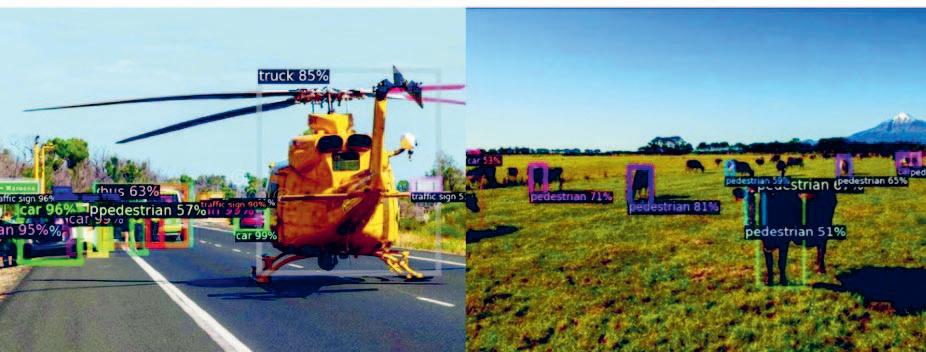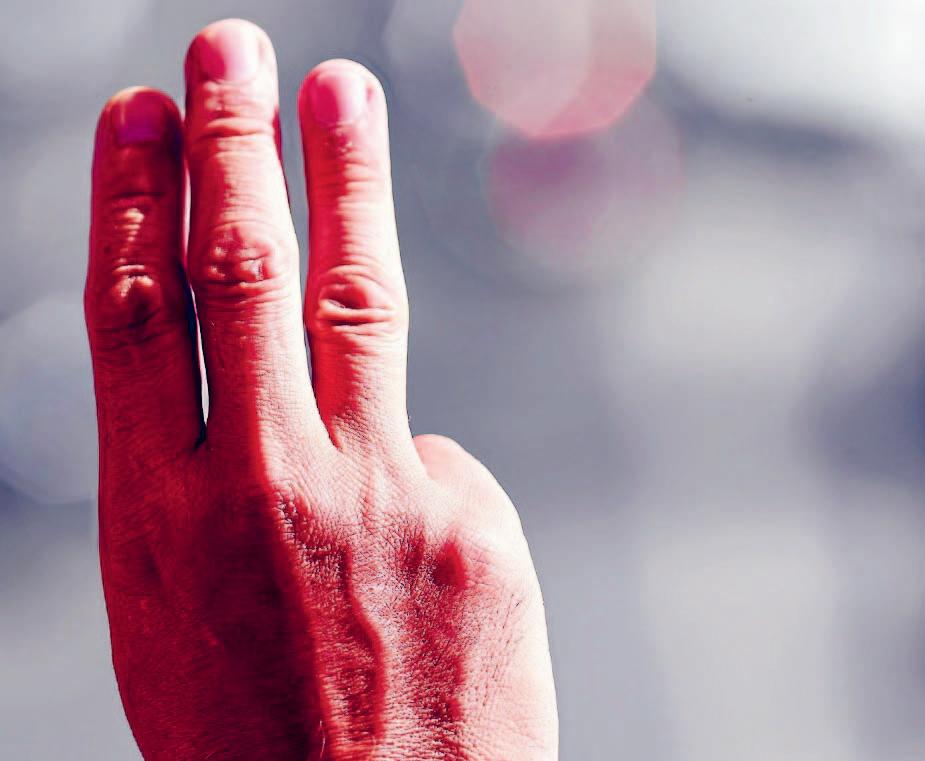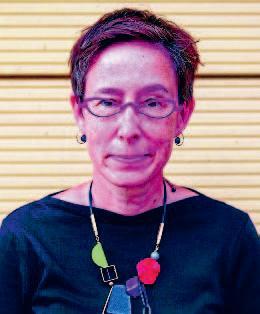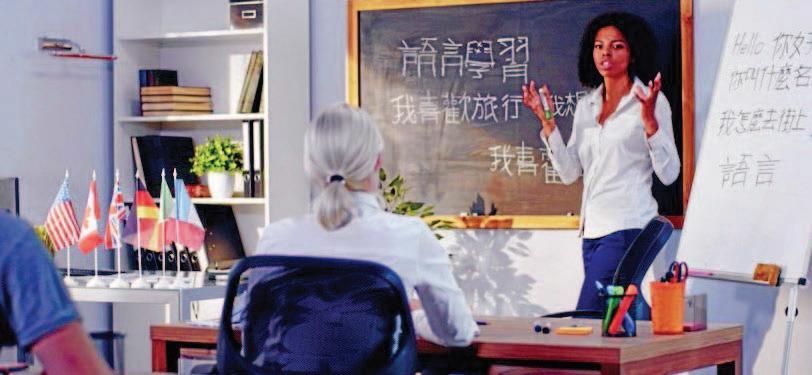
17 minute read
ASSISTANT PROFESSOR OF COMPUTER SCIENCES
DEPARTMENT OF COMPUTER SCIENCES
Making AI safe and reliable
Advertisement
SHARON YIXUAN LI
While artificial intelligence systems have recently achieved remarkable success, they do not necessarily know what they don’t know. As artificial intelligence (AI) expands its role in our lives and reaches society at large, the need for safe and reliable decision-making is increasingly critical. To be trusted with such decisions, our AI systems must be aware of their own uncertainty and limitations and be able to communicate those limitations so that we know when to trust these systems and their predictions.
In machine learning (ML), there exists a major gap between what the model was trained on and what the model will encounter in reality. We typically teach the models by feeding them so-called training data, such as photographs with corresponding class labels (like “dog” or “cat”).
Most machine learning models assume that the data that they’ll see in the future will look a lot like the data they’ve seen in the past (during training). Yet AI systems will inevitably encounter unfamiliar out-of-distribution (OOD) data, which involves new labels and scenarios that were not in the training data. Unfortunately, artificial intelligence in use today can produce overly confident predictions on such OOD data points, even when those data points look nothing like what they’ve seen.
The resulting overconfidence can lead to catastrophic consequences. For example, a medical AI system trained on a certain set of diseases may encounter a different disease (OOD) and cause mistreatment if not detected and handled with caution.
The goal of my research is to bridge the gap. My lab is developing novel deep learning algorithms that enable safe and reliable decision-making for AI in the real world. My research is driven by the following fundamental problem: how can we make modern AI systems know what they don’t know in the face of novel situations and environments, and learn new knowledge over time?
As identified by the Computing Research Association, the problem is largely unexplored and central to the roadmap of artificial intelligence research in the next 5-20 years. My grand vision is to transform deep learning from a closed-world to an open-world setting, where intelligent systems can have an awareness of uncertainty, a mandate to confront unknown situations with caution, and further, a proactive improvement of existing knowledge by learning from the unknowns.
My research will lead to improved safety, reliability, deployability, and durability of modern intelligent systems in realistic open-world environments. My research stands to benefit a wide range of societal activities and applications, including medical diagnosis (such as unseen disease identification), autonomous vehicles (such as unseen object detection), and consumer businesses (such as platform content integrity). We have already made some exciting breakthroughs.
My research is largely inspired by my prior experience developing and deploying real-world machine learning models that are currently serving billions of users. Before joining UWMadison, I was fortunate to spend some time at Facebook AI as a research scientist. The exposure to real-world ML reinforced my belief in the importance of the problem. My research philosophy is “inspired by the real world, built for the real world.” I am grateful for my current job, which allows me to provide direct educational benefits to train the next-generation workforce.
My long-term goal is also to integrate my research with teaching, bridging the educational gap between the fundamental and real-world aspects of modern machine learning approaches. In Fall 2020, I developed and launched a new open-source deep learning course, which covers the building of safe and reliable models. I have also been redesigning the undergraduate AI curricula to reflect these tight connections.
It is a largely unexplored area with so many interesting problems to solve, and I couldn’t be more excited about the journey ahead. I would like to thank the Department of Computer Sciences, the Wisconsin Foundation and Alumni Association and American Family Insurance for sponsoring my research.
An object detection model trained on the self-driving car datasets produces overconfident predictions for out-of-distribution objects (helicopter and cow), resulting in safety and public trust concerns in ML models deployed in the real-world.

About the author
Sharon Yixuan Li is an assistant professor in the Department of Computer Sciences. Her research focuses on developing fundamental algorithms and understandings for uncertainty-aware deep learning, which improves the reliability of modern neural networks. Her research broadly impacts and enables safe decision-making in the real world.
DEPARTMENT OF ASIAN LANGUAGES AND CULTURES
Dictatorship on trial
TYRELL HABERKORN
Judges and historians both construct narratives about who did what, when, and to what end. Historians often treat legal decisions as a source of evidence about state violence, as I do in my research. I may read a case file and then, in my scholarly narrative, offer a different interpretation of the series of events or a different conclusion than the one reached by the judges.
An alternative vision of justice may emerge from a rereading that lays bare a coverup in cases of state violence perpetrated against the people by vicious dictators, or even injustice perpetrated against the people by the court itself, either intentionally or by sleight of hand.
What if the historian stepped out of scholarly narrative and wrote in the voice of a judge and in the format of a decision? Past events or evidence in a decision might be ordered, or even constituted, differently. The evidence needed to hold state perpetrators to account could be brought to the fore, rather than suppressed (in order to exonerate bad actors). Instead of a critique, scholars could offer an alternative vision of justice —and highlight the gap between the law as practiced and law as ideal. I have decided to try this approach.
Inspired by feminist legal scholarship, I recently “picked up the judge’s pen” to write a condensed history of the five years of dictatorship under Thailand’s most recent coup regime, the National Council for Peace and Order (NCPO). The NCPO launched a coup on May 22, 2014, Thailand’s 13th since the end of absolute monarchy in 1932. The NCPO remained in power until July 10, 2019, when a new civilian cabinet was sworn in following elections.
The NCPO’s favorite tool of repression was the law, and hundreds of civilians were prosecuted in political cases for peaceful protest and for simply daring to think differently from those who held power. Anti-coup protests were swiftly shut down. Dissidents were summoned for interrogation and re-education. Activists were sentenced to lengthy prison terms. Law, rather than the extrajudicial violence favored by previous dictatorships, gave the NCPO’s repression a veneer of legitimacy. The junta responded to criticism by stating that they were merely enforcing the law.
Reimagining the meaning of the law in the aftermath of dictatorship is therefore part of moving towards democracy. I selected eight decisions in cases in which the law was used to suppress, rather than support, human rights, and am rewriting them to be more just. Vastly different outcomes are possible under the very same body of law.
Writing in the voice of a judge, and in the form of a decision, has been full of simultaneous discomfort, uncertainty and fun. The contest over law goes from being theoretical and hopeful, to being real and present on the page beneath my pen. As I struggle, sentence by sentence, to rewrite the judges’ decisions, I am learning that the legal decision is not merely a source of evidence for the history I write, but the very site in which to imagine the future anew.

TEERA NOISAKRAN Thailand: Anti-government protesters, holding up three fingers in joining the “CAR MOB” event to drive Prime Minister Prayut Chan-o-cha on the Thanon Vibhavadi Rangsit, Bangkok, on Aug. 1, 2021.
About the author
Tyrell Haberkorn is Professor of Southeast Asian Studies in the Department of Asian Languages and Cultures. She researches state violence and human rights in Thailand and works to use knowledge to challenge injustice. Her most recent book is In Plain Sight: Impunity and Human Rights in Thailand (University of Wisconsin Press, 2018).

LANGUAGE ACQUISITION

EVGENIY SHKOLENKO The world language classroom is a great place to provide guidance on how to market learning experiences in professional settings and how to encourage language use outside of the classroom.
SAKUNI EGODAWATTE
World languages skills are in demand in both the public and private sector, and they have multitudes of benefits beyond just the ability to speak another language. Yet many world languages students don’t fully realize the breadth of their skills, or how to market them in a job interview. Researching the career pathways of world languages students at UWMadison with PhD candidate Ryan Goble in Second Language Acquisition allowed me to understand and tackle this issue—and taught me something important about myself as well.
During the 2019-2020 academic year I was able to sit in on in-depth, recorded interviews with students to find out their perceptions of the language learning classroom and their future career plans. We also had the opportunity to listen to sessions between students and their academic advisors. We closely transcribed these interviews and advising sessions, marking them for significant statements and noting things like hesitance and laughter. Essentially, we learned the hopes and fears of 44 brilliant language students.
We also learned that most students hesitate to be positioned as “fluent” in their world language. They struggle to understand how their many language experiences culminate in skills that they can highlight in interviews, despite advisors giving them lists of what those skills could include. The students were having difficulty seeing themselves reflected in those lists, despite having command over their target languages.
We recognized that the world language classroom is a great place to address these challenges that students are facing, by providing direct guidance on how to market their language learning experiences in professional settings and encouraging language use outside of the classroom.
This experience helped me realize that research wasn’t the insurmountable task that it seemed to be when I first heard about it. It helped me see that research isn’t just people in white coats locked away in a lab, and that it looks vastly different depending on the topic. I learned that the research I conducted could have a direct impact on those around me, and even reach people far away who are looking to improve their own language programs. Who could have known that the late nights spent transcribing hours of other students’ voices could somehow connect me to people I will probably never meet? Empowering my peers through research empowered me, too.
About the author
Sakuni Egodawatte
is majoring in computer sciences and linguistics. Her most recent research was at a Research Experiences for Undergraduates site studying automatic sarcasm detection, to ultimately aid people on the autism spectrum improve social interactions. She grew up in Naperville, Ill., and expects to graduate in May 2022.
DEPARTMENT OF COMPUTER SCIENCES
What is a camera now?
MOHIT GUPTA
We have witnessed a remarkable evolution of camera technology over the past century. Perhaps one of the most profound shifts is that these days, photographs are increasingly created by algorithms, with the role of cameras being merely to capture light. The “raw light capture” is algorithmically and computationally transformed in multiple ways before a photograph is created and consumed. Most modern cameras can thus be thought of as “computational cameras” — they are routinely able to create high-quality photographs even with low-cost devices including cell phones, thus commoditizing a powerful form of visual expression.
Beyond capturing aesthetically pleasing images, such cameras are playing an instrumental role in augmented reality, digital communication, medicine, scientific imaging, and robotics. Robots enabled by such computational cameras are now beginning to autonomously drive cars, explore space, and manage our factories, marking a radical shift in how we go about our daily lives.
With the most common cameras today, such as the one in your cell phone, one can think of each pixel as a light bucket which collects photons. For such cameras, each pixel typically requires capturing hundreds to thousands of photons per pixel to create a reasonable image.
But what if there are cameras that could record individual photons?
There is an emerging class of singlephoton cameras that promise such single-photon sensitivity. Single-photon computational cameras capture images that are algorithmically manipulated at the granularity of individual photons (the minimum amount of measurable light).
For such single-photon cameras, each pixel is like a teaspoon that fills up as soon as it detects a photon. Due to their high sensitivity and (relatively) low costs, single-photon cameras are driving an imaging revolution.
A new generation of devices is emerging, with novel functionalities that were hitherto considered impossible: imaging at a trillion frames-per-second, being able to image around corners, and capturing high-quality images in almost complete darkness. Imagine a camera mounted on a telescope being able to locate a dim astronomical object even in a distant galaxy, or a high-performance scientific camera tracking high-speed cell deformation for facilitating cancer research. Although these singlephoton cameras were long relegated to niche scientific applications, recently they have started making their way to consumer domains (including the new Apple iPhone), placing this exciting technology at the fingertips of billions of people worldwide. Werner Heisenberg, the noted physicist, once said: “What we observe is not nature itself, but nature exposed to our method of questioning.”
By zooming in to individual photons, single-photon cameras allow us to ask some of the most fundamental visual questions from nature, thus getting us closer to its most intimate truths.
On the one hand, the realization that next-generation cameras and algorithms can work synergistically to generate new kinds of photographs, functionalities and visual experiences has profound positive implications — including for photography, robotics, computer vision, medical imaging and AI. On the other hand, this also raises questions about the nature of reality. Can we trust what we see?
It is becoming easier to create photographs and videos of people and events that never were. These include fabricated videos of political speeches, falsified photographic evidence in legal cases, pornography, and manipulated news reel images. Such photos and videos can potentially be weaponized, posing a serious societal risk.
Following these examples, it is easy to picture computational cameras as dangerous devices. However, as scholar Issac Asimov said, “I could not bring myself to believe that if knowledge presented danger, the solution was ignorance. To me, it always seemed that the solution had to be wisdom. You did not refuse to look at danger, rather you learned how to handle it safely. Any technological advance can be dangerous.
Fire was dangerous from the start, and so was speech —and both are still dangerous to this day —but human beings would not be human without them.”
As with any technology, we need the necessary checks and balances in place so that cameras are used responsibly. If we can do this successfully, this new breed of computationally enhanced super-cameras will enable us to see the wonderful world around us in a new light.

About the author
Mohit Gupta is an assistant professor of computer sciences. He directs the WISIONLab with research interests in computer vision and computational imaging. His recent work in computational single-photon imaging is opening up new possibilities for computer vision systems that work in extremely low light, with applications in robotics, scientific imaging and human-computer interfaces.

BARBOL88 There is an emerging class of single-photon cameras that promise single-photon sensitivity. Single-photon computational cameras capture images that are algorithmically manipulated at the granularity of individual photons (the minimum amount of measurable light).
DEPARTMENT OF AFRO-AMERICAN STUDIES
CHRISTINA GREENE
In the summer of 1974, an imprisoned 20-year-old woman named Joan Little defended herself with an ice pick against sexual assault by a white jailer and fled from a rural North Carolina jail. When she learned that the jailer had died and that she had been declared a fugitive — meaning anyone could shoot to kill her on sight — the young, destitute escapee turned herself in to authorities. A grand jury never heard evidence of recent sexual crimes against Little in her jail cell before quickly indicting her for firstdegree murder. If convicted, Little faced execution in the state’s gas chamber.
My forthcoming book from the University of North Carolina Press, tentatively entitled To Whom Will She Cry Rape: Joan Little, and Women’s AntiViolence & Prison Organizing, moves beyond the rape-murder case to cast new light on the intertwined stories of sexual violence, systemic racism and mass incarceration.
The campaign to free Little drew on Black women’s long legacy of anti-rape organizing and testimony, and attracted feminists of all stripes, traditional civil rights and Black Power activists, students, politicians, and prison reformers. Little’s trial featured a pro bono defense team, headed by a white male attorney from her hometown, and included one of the first Black women to graduate from Duke University Law School. The case quickly became a national and international cause célèbre, hailed by the Washington Star newspaper as the “biggest civil rights trial of the ’70s.”
Sounding themes that have reemerged in recent years, the “Free Joan Little” campaign drew attention to the narrow, legal definition of rape; a woman’s right to lethal self-defense against sexual violence; and the underrepresentation of women and Black men on juries. It also highlighted a racially discriminatory criminal legal system that imprisoned and executed disproportionate numbers of African Americans, and that held special dangers for incarcerated women. After a five-week trial in August 1975, a majority female jury, composed equally of Black and white jurors, deliberated for 78 minutes before acquitting Little.
In researching Little’s courtroom victory, it became clear that her treatment by law enforcement and in the courts prior to her more well-known rape-murder trial was far more typical of Black women’s experiences in North Carolina and across the country. Joan likely was a target of racial profiling by local police when she was a teenager and subjected to racially biased sentencing practices.
Many writers focusing on mass incarceration have either ignored female imprisonment or claimed that women prisoners did not engage in organized protest the way men did. My book joins the growing scholarship on women’s prison activism, often inspired by Little’s case, on both sides of the prison walls. Antirape activists, stirred by Little’s predicament and the 1970s trials of other women of color, expanded grass-roots organizing and scored some of their most impressive legal reforms in the 1970s and 1980s.
Despite funding cuts and the decline in rape crisis centers, African American women found creative ways to advocate for their sisters throughout the 1970s, 1980s and beyond. Groups like the newly formed National Black Women’s Health Project (NBWHP) organized women across the country and around the world. NBWHP founder Byllye Avery recalled that violence—rape, incest and intimate partner abuse—soon became their number one issue. Building on the long arc of Black women’s organizing legacy, groups like the NBWHP and the Black feminist Combahee River Collective adopted a multi-issue agenda.
They understood that protection from sexual violence had to encompass access to health care and public transportation, reproductive justice, LGBTQ rights, affordable housing and childcare, a living wage, and an end to racially biased policing and imprisonment.
Nearly a half century before the #MeToo, #SayHerName, and Black Lives Matter movements emerged, African American women raised their voices and took action on the issues at the center of the 21st century’s battles for democracy and justice.

About the author
Christina Greene is a Professor in the Afro-American Studies Department. Her research and teaching focus on the history of women’s activism, Black freedom movements, and race and incarceration in the United States. Joan Little at women’s prison.















